Advertisements
Advertisements
प्रश्न
If two sides of a cyclic quadrilateral are parallel; prove that:
- its other two sides are equal.
- its diagonals are equal.
उत्तर

Given:
ABCD is a cyclic quadrilateral in which AB || DC. AC and BD are its diagonals.
To prove:
- AD = BC
- AC = BD
Proof:
i. AB || DC `=>` ∠DCA = ∠CAB ...[Alternate angles]
Now, chord AD subtends ∠DCA and chord BC subtends ∠CAB
At the circumference of the circle.
∴ ∠DCA = ∠CAB ...[Proved]
∴ Chord AD = Chord BC or AD = BC
ii. Now in ΔABC and ΔADB,
AB = AB ...[Common]
∠ACB = ∠ADB ...[Angles in the same segment]
BC = AD ...[Proved]
By Side – Angle – Side criterion of congruence, we have
ΔACB ≅ ΔADB ...[SAS postulate]
The corresponding parts of the congruent triangles are congruent.
∴ AC = BD ...[c.p.c.t]
APPEARS IN
संबंधित प्रश्न
In the given figure, ∠BAD = 65°, ∠ABD = 70°, ∠BDC = 45°
- Prove that AC is a diameter of the circle.
- Find ∠ACB.

A triangle ABC is inscribed in a circle. The bisectors of angles BAC, ABC and ACB meet the circumcircle of the triangle at points P, Q and R respectively. Prove that:
- ∠ABC = 2∠APQ,
- ∠ACB = 2∠APR,
- `∠QPR = 90^circ - 1/2 ∠BAC`.
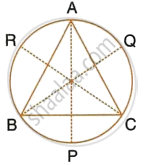
In the given figure, AOC is a diameter and AC is parallel to ED. If ∠CBE = 64°, calculate ∠DEC.
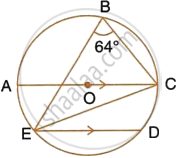
In a cyclic-trapezium, the non-parallel sides are equal and the diagonals are also equal. Prove it.
In the given circle with diameter AB, find the value of x.
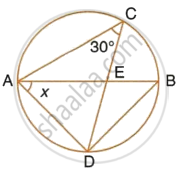
In the figure, given below, AD = BC, ∠BAC = 30° and ∠CBD = 70°.
Find:
- ∠BCD
- ∠BCA
- ∠ABC
- ∠ADB
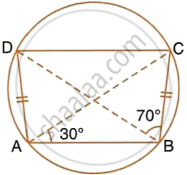
In the figure given alongside, AB and CD are straight lines through the centre O of a circle. If ∠AOC = 80° and ∠CDE = 40°, find the number of degrees in ∠ABC.

A triangle ABC is inscribed in a circle. The bisectors of angles BAC, ABC and ACB meet the circumcircle of the triangle at points P, Q and R respectively. Prove that :
`∠QPR = 90^circ - 1/2 ∠BAC`

In the given Figure. P is any point on the chord BC of a circle such that AB = AP. Prove that CP = CQ.
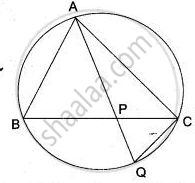
In the given figure (drawn not to scale) chords AD and BC intersect at P, where AB = 9 cm, PB = 3 cm and PD = 2 cm.
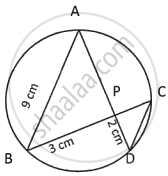
- Prove that ΔAPB ~ ΔCPD.
- Find the length of CD.
- Find area ΔAPB : area ΔCPD.
